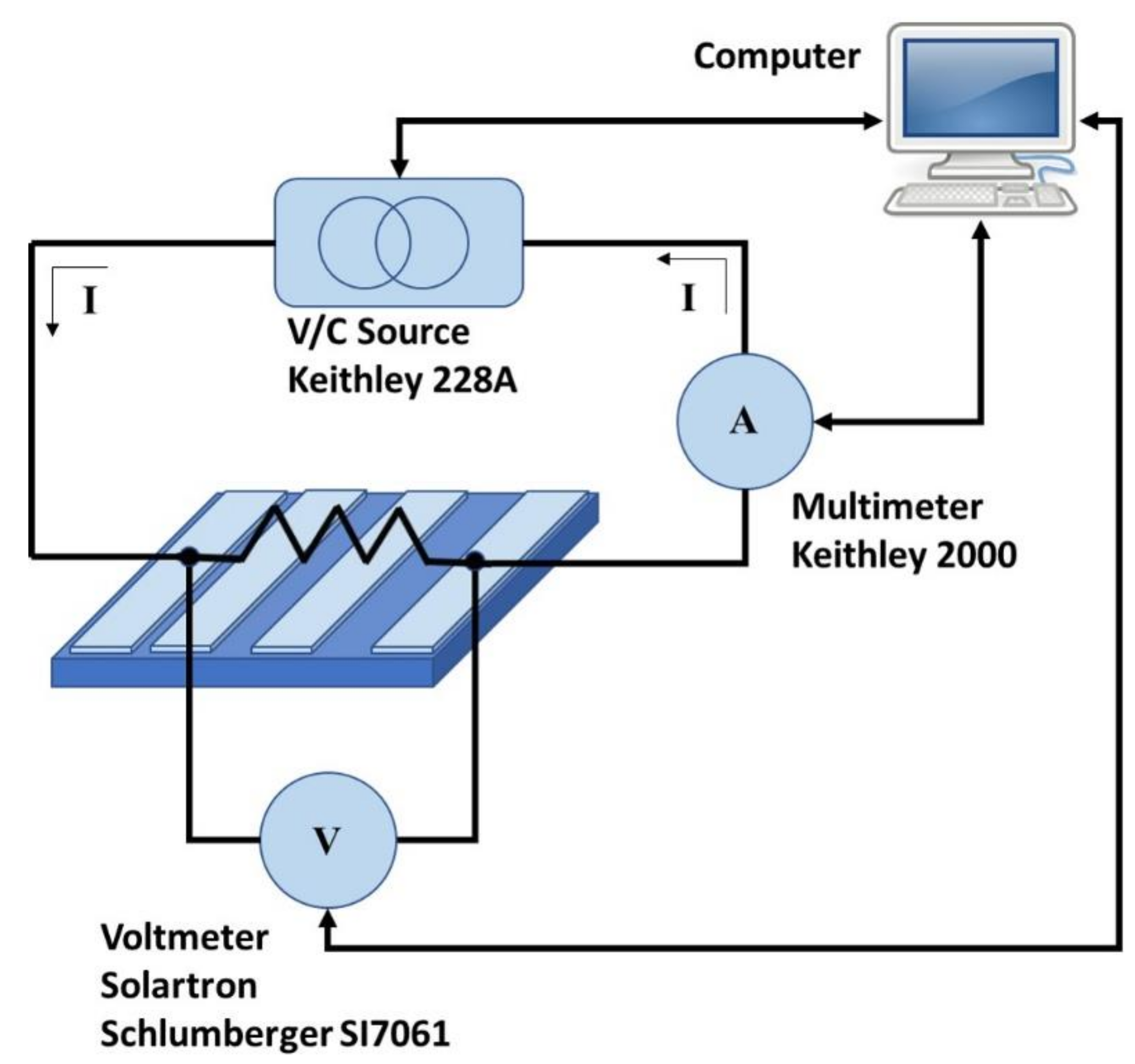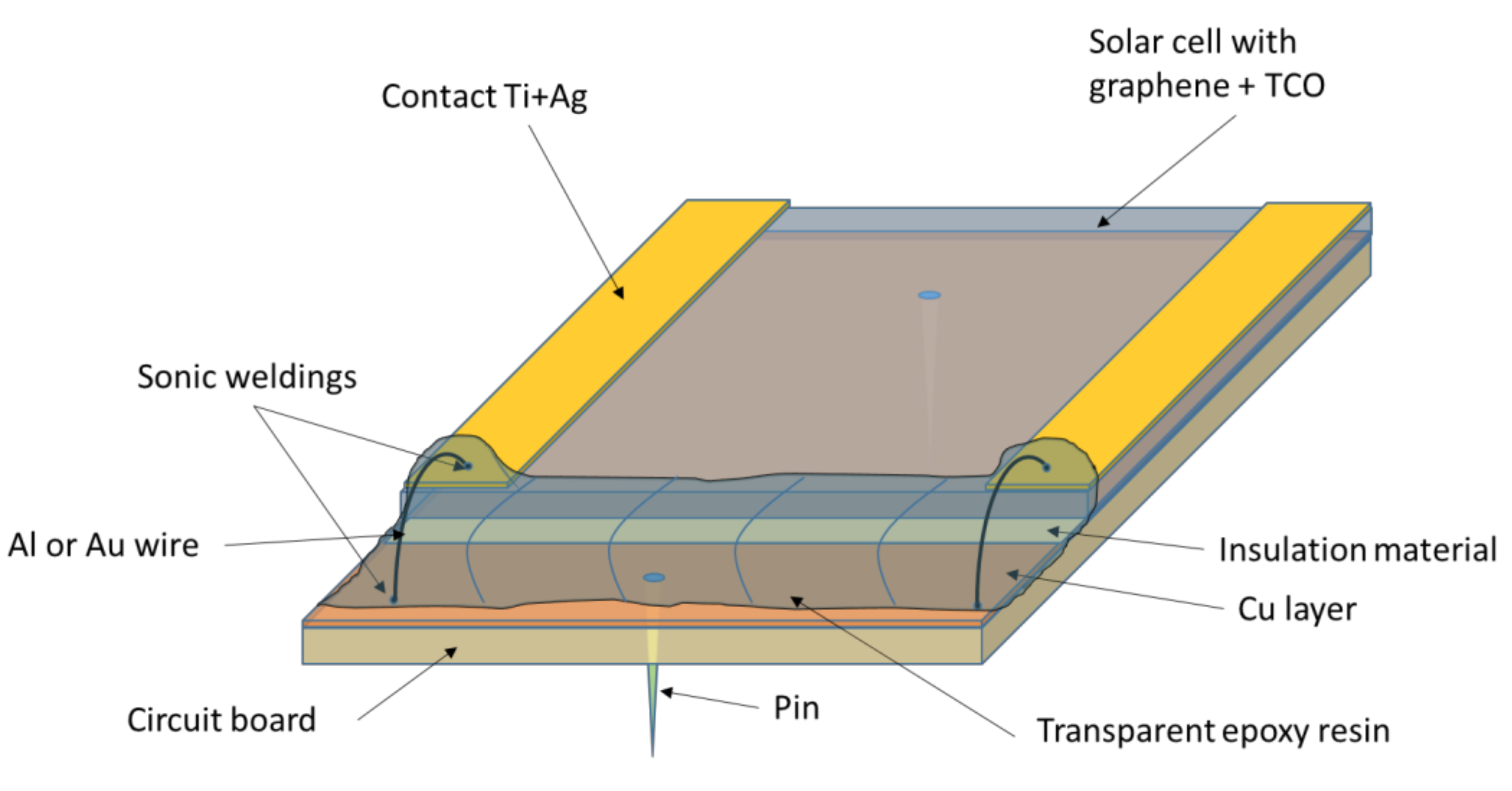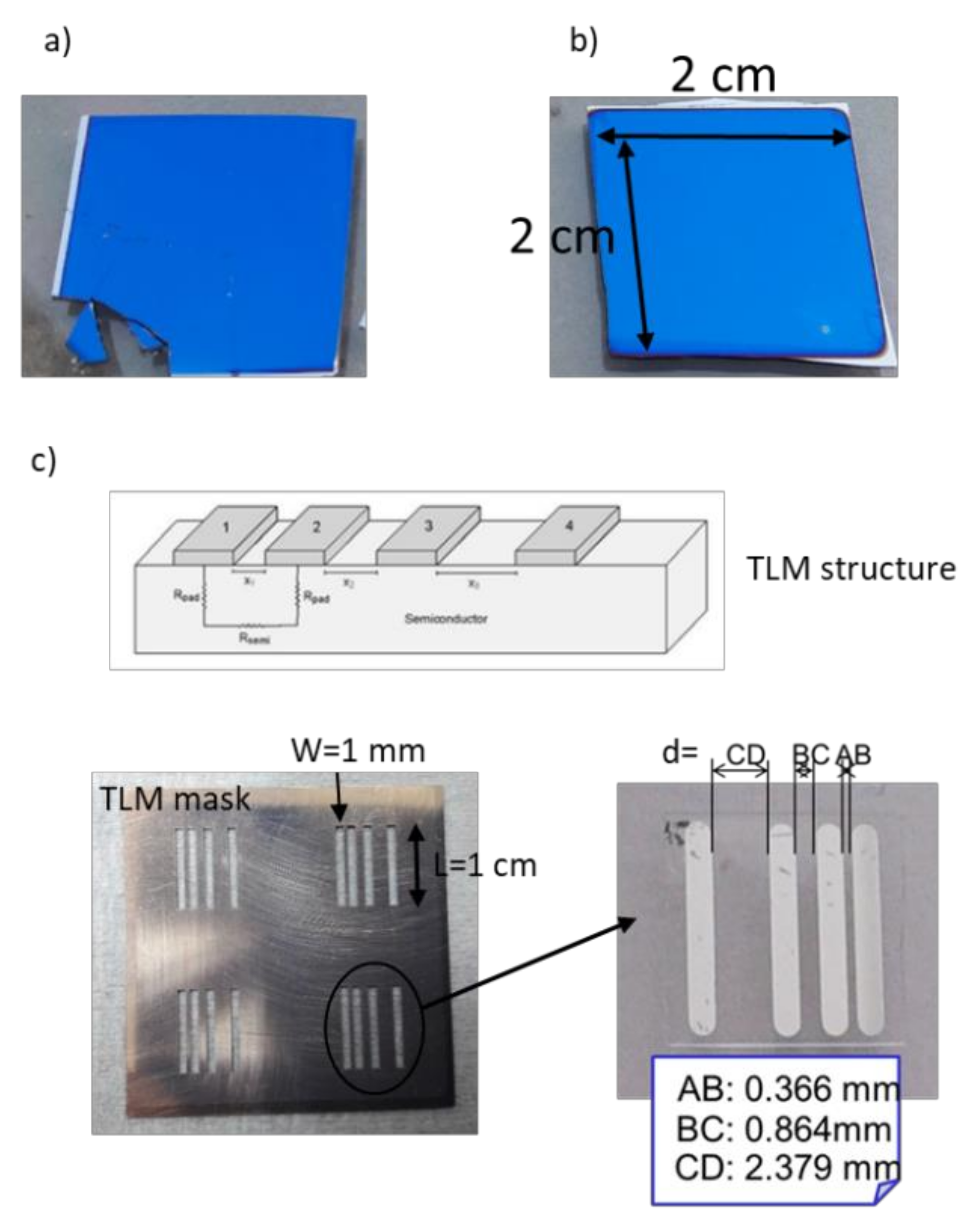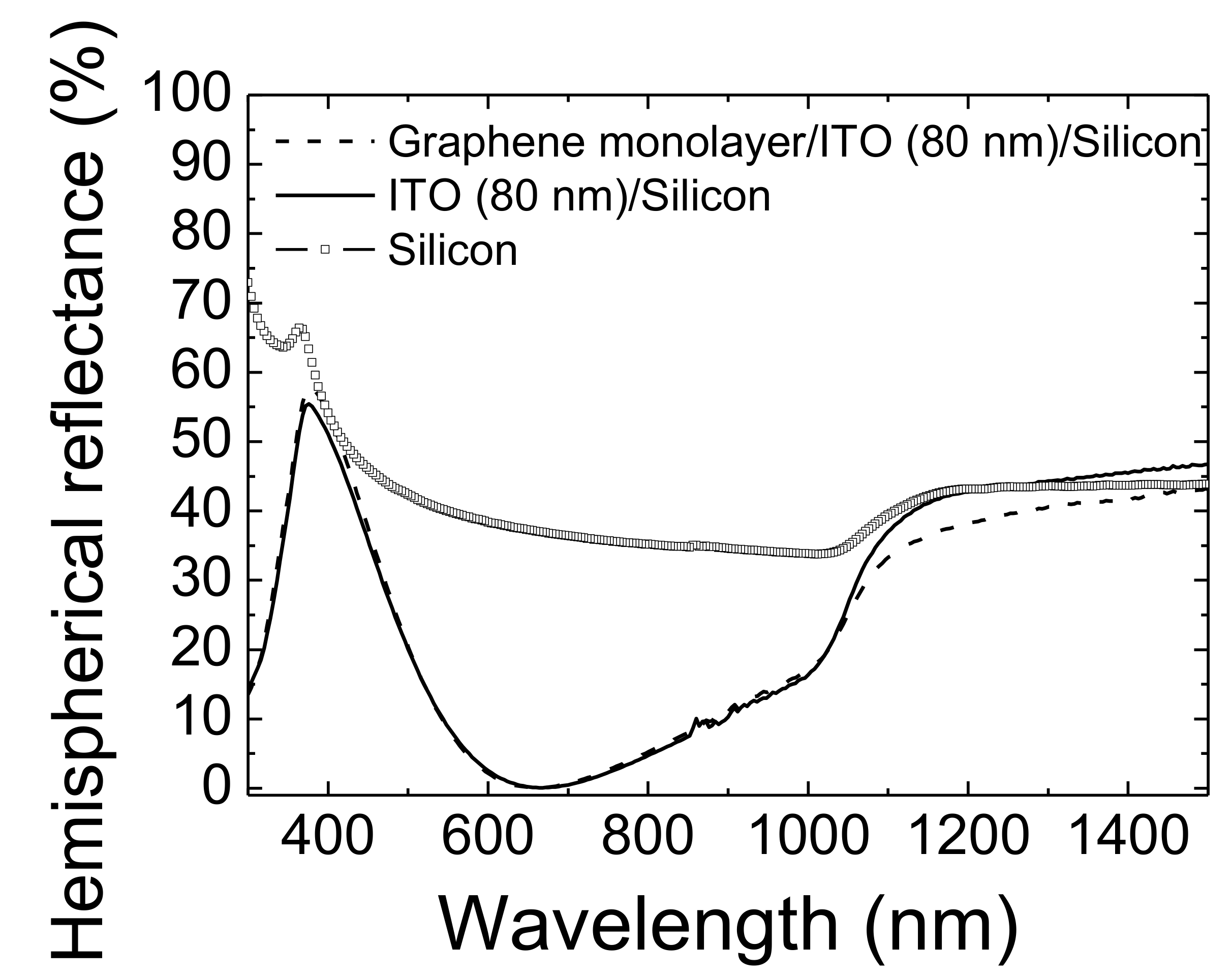Graphene-Based Contacts for Optoelectronic Devices
Abstract
:1. Introduction
2. Materials and Methods
2.1. Graphene-based Transparent Contact Fabrication
2.2. Graphene-based Transparent Contact: Characterization Techniques
2.3. Wire Bonding: Processing and Characterization
3. Results and Discussion
3.1. Optimization of the Metal Stack on Graphene Layers
3.2. Hybrid Graphene/TCO Transparent Contacts
3.2.1. Evaluation of the Compatibility of the Preparation Conditions
3.2.2. Performance of the Hybrid Transparent Contacts
3.2.3. Measurement of the Wire Bonding Resistance
4. Conclusions
Author Contributions
Funding
Conflicts of Interest
References
- Geim, A.K. Graphene Prehistory. Phys. Scr. 2012, 2012, 014003. [Google Scholar] [CrossRef]
- Ruess, G.; Vogt, F. Höchstlamellarer Kohlenstoff aus Graphitoxyhydroxyd. Monatshefte Für Chemie 1948, 78, 222–242. [Google Scholar] [CrossRef]
- Novoselov, K.S.; Geim, A.K.; Morozov, S.V.; Jiang, D.; Zhang, Y.; Dubonos, S.V.; Grigorieva, I.V.; Firsov, A.A. Electric Field Effect in Atomically Thin Carbon Films. Science 2004, 306, 666–669. [Google Scholar] [CrossRef] [Green Version]
- Kusmartsev, F.V.; Wu, W.M.; Pierpoint, M.P.; Yung, K.C. Application of Graphene within Optoelectronic Devices and Transistors. arXiv 2014, arXiv:1406.0809, 1–17. [Google Scholar]
- Bonaccorso, F.; Sun, Z.; Hasan, T.; Ferrari, A.C. Graphene photonics and optoelectronics. Nat. Photon. 2010, 4, 611–622. [Google Scholar] [CrossRef] [Green Version]
- Saive, R.; Borsuk, A.M.; Emmer, H.S.; Bukowsky, C.R.; Lloyd, J.V.; Yalamanchili, S.; Atwater, H.A. Effectively Transparent Front Contacts for Optoelectronic Devices. Adv. Opt. Mater. 2016, 4, 1470–1474. [Google Scholar] [CrossRef]
- Tonny, K.N.; Rafique, R.; Sharmin, A.; Bashar, M.S.; Mahmood, Z.H. Electrical, optical and structural properties of transparent conducting Al doped ZnO (AZO) deposited by sol-gel spin coating. AIP Adv. 2018, 8, 065307. [Google Scholar] [CrossRef] [Green Version]
- Ikhmayies, S. Chapter 70—Transparent Conducting Oxides for Solar Cell Applications. In Mediterranean Green Buildings & Renewable Energy; Springer International Publishing: Basel, Switzerland, 2017; pp. 899–907. [Google Scholar] [CrossRef]
- Fernández, S.; Garrido Marijuan, A. Chapter 11—High-Tech Applications of Functional Coatings: Functional Coatings and Photovoltaic. In Research Perspectives on Functional Micro- and Nanoscale Coatings; IGI Global: Hershey, PA, USA, 2016; pp. 289–317. [Google Scholar] [CrossRef]
- Cruz, A.; Erfurt, D.; Köhler, R.; Dimer, M.; Schneiderlöchner, E.; Stannowski, B. Industrial TCOs for SHJ solar cells: Approaches for optimizing performance and cost. In Photovoltaics International, 44th ed.; Solar Media Limited: London, UK, 2020; p. 86. Available online: https://store.pv-tech.org/product-tag/photovoltaics-international-volume-44/ (accessed on 1 June 2020).
- Fernández, S.; Naranjo, F.B. Optimization of aluminum-doped zinc oxide films deposited at low temperature by radio-frequency sputtering on flexible substrates for solar cell applications. Sol. Energy Mater. Sol. Cells 2010, 94, 157–163. [Google Scholar] [CrossRef]
- Zinchenko, T.O.; Pecherskaya, E.A.; Nikolaev, K.O.; Golubkov, P.E.; Shepeleva, Y.V.; Artamonov, D.V. The study of the optical properties of transparent conductive oxides SnO2:Sb, obtained by spray pyrolysis. J. Phys. Conf. Ser. 2019, 1410, 012090. [Google Scholar] [CrossRef]
- Meza, D.; Cruz, A.; Morales-Vilches, A.B.; Korte, L.; Stannowski, B. Aluminum-Doped Zinc Oxide as Front Electrode for Rear Emitter Silicon Heterojunction Solar Cells with High Efficiency. Appl. Sci. 2019, 9, 862. [Google Scholar] [CrossRef] [Green Version]
- Yu, L.; Shearer, C.; Shapter, J. Recent development of carbon nanotube transparent conductive films. Chem. Rev. 2016, 116, 13413–13453. [Google Scholar] [CrossRef] [PubMed]
- Luo, M.; Liu, Y.; Huang, W.; Qiao, W.; Zhou, Y.; Ye, Y.; Chen, L.-S. Towards flexible transparent electrodes based on carbon and metallic materials. Micromachines 2017, 8, 12. [Google Scholar] [CrossRef]
- Ye, S.; Rathmell, A.R.; Chen, Z.; Stewart, I.E.; Wiley, B.J. Metal nanowire networks: The next generation of transparent conductors. Adv. Mater. 2014, 26, 6670–6687. [Google Scholar] [CrossRef]
- Lee, K.T.; Park, D.Y.; Baac, H.W.; Han, S. Graphene and carbon nanotube based transparent electrodes for semitransparent solar cells. Materials 2018, 11, 1503. [Google Scholar] [CrossRef] [PubMed] [Green Version]
- Kholmanov, I.N.; Domingues, S.H.; Chou, H.; Wang, X.; Tan, C.; Kim, J.-Y.; Li, H.; Piner, R.; Zarbin, A.J.G.; Ruoff, R.S. Reduced Graphene Oxide/Copper Nanowire Hybrid Films as High-Performance Transparent Electrodes. ACS Nano 2013, 7, 1811–1816. [Google Scholar] [CrossRef] [PubMed]
- Woo, Y.S. Transparent conductive electrodes based on graphene-related materials. Michomachines 2019, 10, 13. [Google Scholar] [CrossRef] [Green Version]
- Giubileo, F.; Di Bartolomeo, A. The role of contact resistance in graphene field-effect devices. Prog. Surf. Sci. 2017, 92, 143–175. [Google Scholar] [CrossRef] [Green Version]
- Yue, D.W.; Ra, C.H.; Liu, X.C.; Lee, D.Y.; Yoo, W.J. Edge contacts of graphene formed by using a controlled plasma treatment. Nanoscale 2015, 7, 825–831. [Google Scholar] [CrossRef]
- Gahoi, A.; Wagner, S.; Bablich, A.; Kataria, S.; Passi, V.; Lemme, M.C. Contact resistance study of various metal electrodes with CVD graphene. Solid-State Electron. 2016, 125, 234–239. [Google Scholar] [CrossRef]
- Zhong, H.; Zhang, Z.; Chen, B.; Xu, H.; Yu, D.; Huang, L.; Peng, L. Realization of low contact resistance close to theoretical limit in graphene transistors. Nano Res. 2015, 8, 1669–1679. [Google Scholar] [CrossRef]
- Labie, R.; Bearda, T.; El Daif, O.; O’Sullivan, B.; Baert, K.; Gordon, I. Resistance and passivation of metal contacts using n-type amorphous Si for Si solar cells. J. Appl. Phys. 2014, 115, 183508. [Google Scholar] [CrossRef]
- Wu, H.-Y.; Hsu, C.-H.; Lien, S.-Y.; Jiang, Y.-L. Aluminum–Titanium Alloy Back Contact Reducing Production Cost of Silicon Thin-Film Solar Cells. Energies 2016, 9, 975. [Google Scholar] [CrossRef] [Green Version]
- Couderc, R.; Amarab, M.; Lemitia, M. Improvement of back surface metallization in a silicon interdigitated back contacts solar cell. Energy Procedia 2013, 38, 684–690. [Google Scholar] [CrossRef]
- Available online: https://www.graphenea.com/pages/cvd-graphene#.XpwPesgzbIV (accessed on 1 October 2020).
- Nagashio, K.; Nishimura, T.; Kita, K.; Toriumi, A. Contact resistivity and current flow path at metal/graphene contact. Appl. Phys. Lett. 2010, 97, 143514. [Google Scholar] [CrossRef]
- Mimila-Arroyo, J.; Herrera-Bernal, M.G. Extension of Schockley’s transmission line method (TLM) to characterize ohmic contacts. Semicond. Sci. Technol. 2017, 32, 055001. [Google Scholar] [CrossRef]
- Available online: https://www.fsbondtec.at/wp-content/uploads/2018/12/5632_EN.pdf (accessed on 1 October 2020).
- Schroder, D.K. Semiconductor Material and Device Characterization; John Wiley & Sons: Hoboken, NJ, USA, 2006; ISBN 0471739065. [Google Scholar]
- Robinson, J.A.; LaBella, M.; Zhu, M.; Hollander, M.; Kasarda, R.; Hughes, Z.; Trumbull, K.; Cavalero, R.; Snyder, D. Contacting graphene. Appl. Phys. Lett. 2011, 98, 053103. [Google Scholar] [CrossRef]
- Rashad, M.; Pan, F.; Yu, Z.; Asif, M.; Lin, H.; Pan, R. Investigation on microstructural, mechanical and electrochemical properties of aluminum composites reinforced with graphene nanoplatelets. Prog. Nat. Sci. Mater. 2015, 25, 460–470. [Google Scholar] [CrossRef] [Green Version]
- Krupka, J.; Strupinski, W. Measurements of the sheet resistance and conductivity of thin epitaxial graphene and SiC films. Appl. Phys. Lett. 2010, 96, 082101. [Google Scholar] [CrossRef]
- Moon, J.S.; Antcliffe, M.; Seo, H.C.; Curtis, D.; Lin, S.; Schmitz, A.; Milosavljevic, I.; Kiselev, A.A.; Ross, R.S.; Gaskill, D.K.; et al. Ultra-low resistance ohmic contacts in graphene field effect transistors. Appl. Phys. Lett. 2012, 100, 203512. [Google Scholar] [CrossRef]
- Zhu, S.E.; Yuan, S.; Janssen, G.C.A.M. Optical transmittance of multilayer graphene. EPL Europhys. Lett. 2014, 108, 17007. [Google Scholar] [CrossRef] [Green Version]
- Ahlberg, P.; Johansson, F.O.L.; Zhang, Z.B.; Jansson, U.; Zhang, S.L.; Lindblad, A.; Nyberg, T. Defect formation in graphene during low energy ion bombardment. APL Mater. 2016, 4, 046104. [Google Scholar] [CrossRef]
- Raut, H.K.; Ganesh, V.A.; Nair, A.S.; Ramakrishna, S. Anti-reflective coatings: A critical, in-depth review. Energy Environ. Sci. 2011, 4, 3779–3804. [Google Scholar] [CrossRef]
- Haacke, G. New figure of merit for transparent conductors. J. Appl. Phys. 1976, 47, 4086. [Google Scholar] [CrossRef]
- Abushanab, W.S.; Moustafa, E.B.; Ghandourah, E.; Taha, M.A. Effect of graphene nanoparticles on the physical and mechanical propertiesof the Al2024-graphene nanocomposites fabricated by powder metallurgy. Results Phys. 2020, 19, 103343. [Google Scholar] [CrossRef]
- Yolshina, L.A.; Muradymov, R.V.; Vichuzhanin, D.I.; Smirnova, E.O. Enhancement of the Mechanical Properties of Aluminum Graphene Composites. AIP Conf. Proc. 2016, 1785, 040093. [Google Scholar] [CrossRef] [Green Version]






| Metal stack | Ti + Ag | Al | Ni + Al | Pd |
|---|---|---|---|---|
| Rs (Ω/sq) (1) | 399 ± 4 | 843 ± 362 (*) | 383 ± 16 (*) | 328 ± 12 |
| ρc (Ω-cm2) | (2.6 ± 0.5) × 10−4 | (4.1 ± 0.3) × 10−1 | (2.1 ± 0.7) × 10−4 | (1.50 ± 0.04) × 10−1 |
| LT (cm) | (2.80 ± 0.03) × 10−3 | (2.57 ± 0.01) × 10−2 | (1.80 ± 0.05) × 10−3 | (2.14 ± 0.08) × 10−3 |
| Rs (Ω/sq) (3) | 120 ± 5 | - | - | 120 ± 11 |
| ρc (Ω-cm2) | (6.5 ± 3) × 10−3 | - | - | (4.30 ± 0.08) × 10−2 |
| LT (cm) | (7.3 ± 0.5) × 10−3 | - | - | (3.6 ± 0.8) × 10−4 |
| Number of Graphene Monolayers | Average White-light Transmission (%) | Rs (Ω/sq): Transferred at High Temperature on Resistive Glass | Rs (Ω/sq): Transferred at Low Temperature on Resistive Glass | Nominal Rs (Ω/sq): Transferred at Standard Conditions on SiO2/Si |
|---|---|---|---|---|
| 1 | 97.6 ± 1.0 | 375 ± 25 | 295 ± 25 | 350 ± 50 |
| 2 | 95.7 ± 1.0 | 175 ± 10 | 155 ± 10 | 188 ± 3 |
| 3 | 93.3 ± 0.9 | 120 ± 15 | 125 ± 15 | 126 ± 6 |
| Sample | Rs (Ω/sq) | Average White-light Transmission (%) |
|---|---|---|
| ITO (40 nm)/Glass | 196.5 ± 1.0 | 89 ± 5 |
| 3 Graphene monolayers/Quartz | 120.0 ± 5.0 | 93 ± 2 |
| Structure 1: 3 Graphene monolayers/ITO (40 nm)/Glass | 156.5 ± 15 | 80 ± 6 |
| Structure 2: ITO (40 nm)/3 graphene monolayers/Quartz | 200.0 ± 34.0 | 78 ± 4 |
| No. Graphene Monolayers | 80 nm-Thick TCO Material | Rs (Ω/sq) | Average White-Light Transmission (%) | FOM (× 10–4 Ω–1) |
|---|---|---|---|---|
| 2 | AZO | 890 ± 70 | 86 ± 2 | 2.4 ± 0.9 |
| 3 | AZO | 116 ± 6 | 80 ± 3 | 9.2 ± 0.5 |
| 1 | ITO | 72 ± 5 | 85 ± 2 | 27.3 ± 0.4 |
© 2020 by the authors. Licensee MDPI, Basel, Switzerland. This article is an open access article distributed under the terms and conditions of the Creative Commons Attribution (CC BY) license (http://creativecommons.org/licenses/by/4.0/).
Share and Cite
Fernández, S.; Molinero, A.; Sanz, D.; González, J.P.; Cruz, M.d.l.; Gandía, J.J.; Cárabe, J. Graphene-Based Contacts for Optoelectronic Devices. Micromachines 2020, 11, 919. https://doi.org/10.3390/mi11100919
Fernández S, Molinero A, Sanz D, González JP, Cruz Mdl, Gandía JJ, Cárabe J. Graphene-Based Contacts for Optoelectronic Devices. Micromachines. 2020; 11(10):919. https://doi.org/10.3390/mi11100919
Chicago/Turabian StyleFernández, Susana, Antonio Molinero, David Sanz, José Pablo González, Marina de la Cruz, José Javier Gandía, and Julio Cárabe. 2020. "Graphene-Based Contacts for Optoelectronic Devices" Micromachines 11, no. 10: 919. https://doi.org/10.3390/mi11100919





